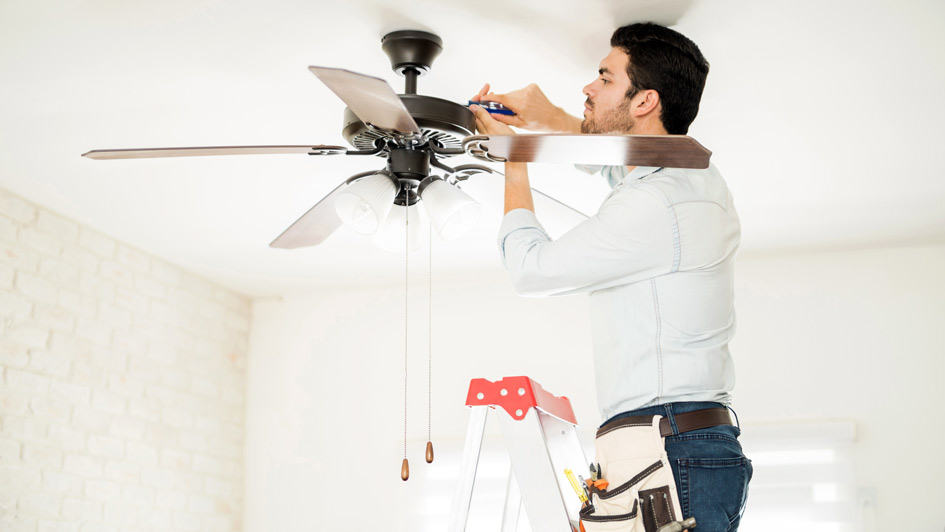
Ceiling fans are one of the most overlooked ways to increase home comfort and reduce energy costs. By enhancing air circulation and assisting your HVAC system, ceiling fans and energy efficiency are truly a match made in heaven. They offer a practical, cost-saving way to maintain your comfort in hot weather while easing strain on your AC—even preventing unnecessary air conditioning repair.
In this blog, the experts at Service Max Heating & Air Conditioning break down how ceiling fans can make your home feel more comfortable while saving you money thanks to increased HVAC efficiency. We'll also offer some HVAC efficiency tips that take advantage of ceiling fans.
Comfort vs. Temperature: The Effect of the Wind-Chill Effect Indoors
Ceiling fans don’t actually cool the air—they make your home more comfortable by moving air over your skin. This is known as the wind-chill effect, and it can make a room feel up to 4 degrees cooler without touching the thermostat. That means you stay comfortable and enjoy the benefits of indoor air circulation from your ceiling fan while minimizing air conditioner use—helping reduce your electric bill in summer.
The Best of Both: Advantages of Pairing Fans and Air Conditioning Together
There are several benefits to using ceiling fans and air conditioning together, especially on hotter days. By using both, you boost HVAC efficiency and keep your home cooler with less effort from your cooling system.
Top perks of using ceiling fans and AC together:
- Ceiling fans help lower HVAC load by circulating cool air more evenly around a room. Decreasing HVAC stress is important, because it can prevent a breakdown that could result in premature AC or furnace installation.
- Using overhead fans enhances comfort by eliminating hot spots and enhancing circulation.
- Pairing ceiling fans and AC can reduce overall energy use. If you have a home automation system, you can even modify your smart thermostat settings to bump up the temp a few degrees while your ceiling fan is running.
Clockwise vs. Counterclockwise Ceiling Fan Rotation: Which Direction Should a Fan Spin?
To maximize the benefits of your ceiling fans year-round, it’s important to ensure blades are rotating in the proper direction for the season. The direction affects how air circulates, which can either or gently recirculate warm air so you feel warmer.
When it's best to spin ceiling fans counterclockwise
When it's hot outside, ceiling fans should rotate counterclockwise at a faster setting. This creates a breeze that forces cool air down, increasing the wind-chill effect and making you feel cooler.
When it's best to spin ceiling fans clockwise
On cold days, set your fan to spin clockwise on a low speed. This gently pulls cool air upward and draws warm air downward from the ceiling, helping you feel warmer without adjusting your thermostat.
How to Pick Out the Best Ceiling Fan for My Home
Selecting the ideal ceiling fan depends on a few important details, such as blade design, airflow rating and room dimensions. First, look for fans that offer a good combination of ECFM airflow and blade pitch to ensure efficient air movement in your space:
- ECFM is the amount of air a fan pushes—the cubic feet per minute, or CFM—per watt of electricity consumed. Fans with greater ECFM are the most energy efficient.
- Blade pitch refers to the angle of the blades. A sharper blade pitch increases airflow but can also stress the fan’s motor.
Also, consider room size when sizing a ceiling fan—a fan that’s too small won’t circulate sufficient air, while one that’s too big may be disruptive in a smaller room.
Increase Your HVAC Efficiency With the Experts from Service Max Heating & Air Conditioning
At Service Max Heating & Air Conditioning, our HVAC experts can help you stay comfortable while reducing strain on your heating and cooling systems. From practical fan advice and air conditioning installation to smart thermostats and furnace repair, we offer comprehensive solutions that fit your lifestyle. Schedule your appointment by calling 360-939-9033 today.
